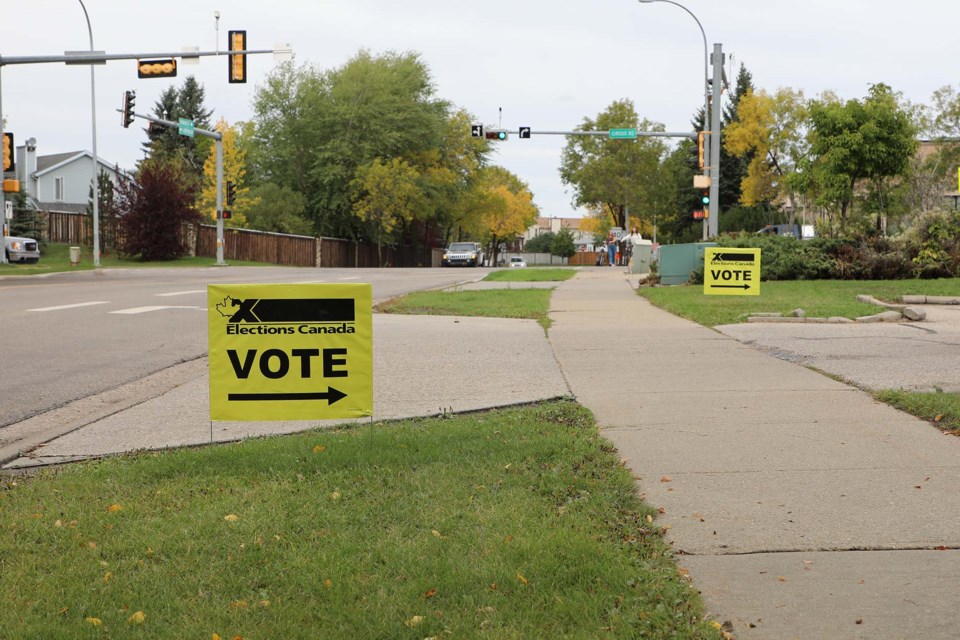Alberta’s new public-health restrictions won’t impact the voting process as St. Albert voters head to the polls on Monday.
“Elections Canada has communicated with the Alberta public health authority and I can confirm there will be no changes to the voting process and for electors and election day,” said Leanne Nyrifa, Elections Canada’s regional media advisor for Alberta, in an email.
On Sept. 15 the province declared a state of public health emergency, and with that declaration came new health restrictions, including capacity limits and proof of vaccination status for discretionary events and businesses, but those new health restrictions will not apply to voting facilities.
Nyrifa said in a Sept. 17 email, polling places are not considered to be discretionary events and businesses, and facilities that are being used for electoral operations are not subject to the capacity limits that may otherwise be imposed on facilities that choose not to verify vaccination status.
Voters will not be required to provide vaccination status.
“There is no expectation to check proof of vaccination for either our workers or electors,” Nyrifa said.
However, masking will continue to be mandatory for both voters and workers. Other health and safety precautions will also be in place, including physical distancing, Plexiglass barriers, use of hand sanitizer, and single-use pencils.
Polling stations will be open from 7:30 a.m. until 7:30 p.m. on Sept. 20.
The deadline for mail-in and special ballots is also 7:30 p.m. on Sept 20.
The deadline to request a mail-in ballot was Sept. 14.
There were 3,099 voting kits issued to St. Albert-Edmonton electors voting by mail or at an Elections Canada office voting inside their riding, according to data from Elections Canada, current as of Sept. 16. Of those voting kits, 2,493 have already been returned.
In an interview, Nyrifa said if voters are concerned about their ballots getting back in time through the mail, they can always drop off their ballots at the local elections office before the polls close.
“Or, if you're worried, you can also drop it off at your assigned polling place. Or another polling place in your riding on election day,” she said.
For electors from the St. Albert-Edmonton riding who live outside their riding, 789 voting kits were issued, 306 of those kits have been returned.
For voters who are living outside of their riding, either in Canada or another country, electors need to have their ballots back by 6 p.m. EDT on election day.
“That's because those kits go back to Ottawa, they don't stay in the riding,” she said.
For St. Albert-Edmonton voters living outside of Canada, 139 voting kits have been issued, and of those kits, 53 have been returned to Elections Canada to be tallied.
Altogether, there has been a total of 4,027 mail-in and special ballot voting kits issued for the St. Albert-Edmonton riding, and 2,852 of those have been returned.
Counts for the local mail-in ballots won’t begin until the day after the election.
“So, according to the Canada Elections Act, that really lays out for us when each type of ballot can start to be counted. So, the local special ballots, like the mail-in ballots, can only be counted after the polls close,” said Nyrifa in an interview.
Nyrifa said there is a verification process that takes place before those ballots are counted. That process includes looking at the outer information on the envelope and making sure it matches up with the information in the application and that the elector has signed the mandatory declaration.
“We'll be checking the list to see if that voter has already voted. If they have at a polling station, we'll know because we have lists of people who have voted and have not. And then we'll need to make sure that we've received the ballot on time,” she explained.
After that, they begin the count.
“So, that's why we really don't expect the count to begin on those ballots until the day after. And it's hard to say how long it's going to take,” she said.
Nyrifa said it could take a couple of days before they receive the final results.
“And even at that, they're always preliminary results until all verifications are made,” she continued.
Elections Canada was planning on an increase in special and mail-in ballots for this election, and mid-August analysis revealed two to three million Canadians might have chosen that route.
The figures are not as high as anticipated. The total number of voting kits issued to electors is 1,253,987 with 811,235 voting kits returned to date.
Voting kits issued to people living in their riding is 1,013,371 with 706,627 of them already returned. For voters living outside of their riding, there have been 184,919 voting kits issued and 84,915 of those have been returned. The number of voting kits issued to people living outside of Canada is 55,697 with 19,693 of the kits returned to date.
These numbers have substantially increased from the 43rd general election in 2019.
In 2019, the number of international ballots was 34,144. For voters living in Canada but voting nationally, the number was 15,405, and locally, the number of special ballot kits issued was 5,000.
“This is for the whole country [and it] was only about 5,000. So, the total number of mailing kits last election was 55,000. This election we’re at [more than a million]. Now, that number might change, as there's still some numbers coming in. But yes, it's quite different,” she said.
With such a tight race predicted by multiple electoral projections, whether or not the mail-in ballots will impact when we get the final results of the election in certain ridings and in Canada overall has yet to be seen.
“It's hard to say, you know, there are situations where the vote is close in certain areas. Absolutely, it could,” said Nyrifa.




